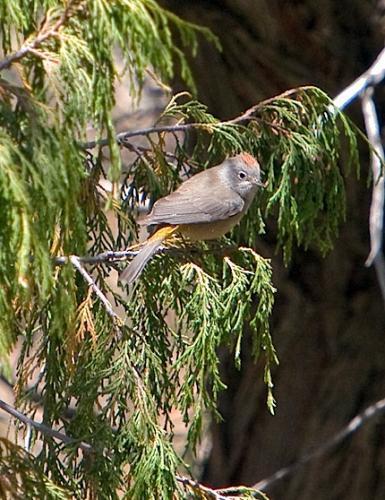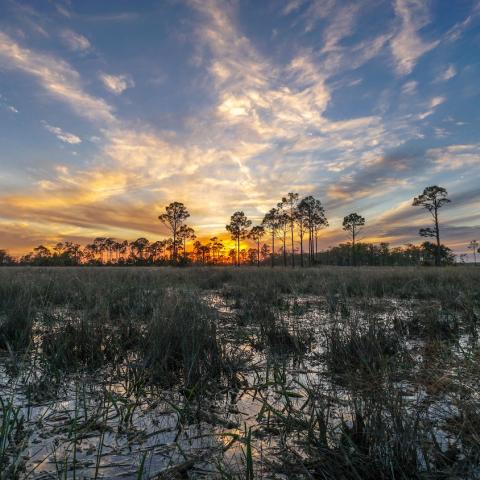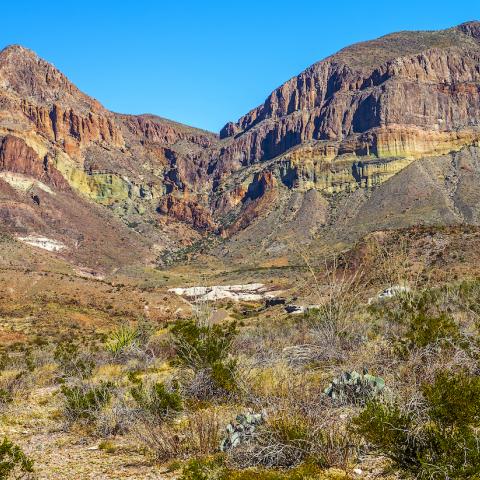
The Colima Warbler is a gorgeous bird that heads to Big Bend National Park in the spring to mate and nest before flitting back south to Mexico/Jim and Lynne Weber
Has anyone out there in Traveler land seen The Big Year with Steve Martin, Jack Black, and Owen Wilson?
Apparently not many have, since the movie is tanking at the box office. I might have better luck asking if anyone has read the book by Mark Obmascik upon which the movie is based.
For the uninitiated, a "big year" is the term applied to a birder venturing forth to see as many birds as possible in North America within one calendar year. There are no referees and no prizes. It’s all about honor and glory.
About 675 birds reside at some point of the year somewhere in North America. (For big year purposes, North America is defined as the contiguous 48 states, Canada, Alaska, and Greenland.) Sandy Komito holds the big year record with 745 (or 748, depending on some technicalities) species of birds. That means he got almost every single resident, plus dozens of rare vagrants that wandered in from Europe, Asia, or Mexico.
Mexico being excluded from North America forces big year participants to the United States’ southern border to spot Mexican birds that stray across the imaginary line. I was disappointed that the movie didn’t show one of the grandest spots the birders have to visit: Big Bend National Park.
Big Bend is home to a dizzying assortment of plants and animals, including more than 400 birds. One of those in particular, the Colima Warbler (Oreothlypis crissalis), is what brings those in search of big year glory to the Chisos Mountains.

The landscape of Big Bend National Park is a favorite with the Colima Warbler. Photo by Dawn Fine, used with permission.
South of the border there is no scarcity of Colima Warblers despite a rather limited breeding range.
Every spring, a hundred or more individuals leave their wintering grounds, heading north into Big Bend to find a mate, nest, and then high-tail it back to Mexico.
The preferred nesting habitat is in lush growth of oak, maple, and pinyon pine with extensive grass and leaf litter on the ground where the actual nest is constructed. In the Chisos Mountains, this translates to the north-facing slopes of humid canyons above 6,000 feet.
Veterans of Big Bend hiking may already be picturing the Pinnacles Trail and Boot Canyon, and that would be precisely where you are most likely to find the Colima Warbler in April or May. This is when a birder, particularly one determined to set a big year record, needs to be in good physical condition. The Pinnacles Trail is a steep climb and Big Bend can be awfully hot by the time the warblers arrive in mid-April.
An alternative to climbing the Pinnacles is the Laguna Meadows Trail and the aptly-named Colima Trail that connects back to the Pinnacles for a knee-busting descent. Either way, this is a bird that makes you work to tick it off your life list.
Thankfully, some of the world’s best scenery awaits the birder making this pilgrimage. Once in an open spot near some grass and trees, it’s a relatively simple matter to find the target. The Colima Warbler has a distinctive song with a rapid trill. An MP3 recording can train your ear to listen for the proper tune. (Here’s a link to the song, with the best part at about 1:50 in this recording.)
Birders differ in opinion about the ethics of using a broadcast playback of the song to call in birds in the field. It certainly works, but can potentially stress and confuse nesting birds.

Colima warblers love grassy habitat, such as that found in Big Bend. Photo by Dawn Fine, used with permission.
Since Colima Warblers are relatively easy to find anyway, I’m not in favor of any use of playback, and I’m not ever sure if it’s legal to do at this time in the national park.
A simple pishing can often bring them into view without causing them the alarm of thinking there’s an intruder in their territory.
Pishing is the act of making a noise that sounds like PSSSH several times. Many small birds seem to be curious about that kind of noise and will appear briefly to check it out. Most warblers aren’t very responsive to pishing, but Colimas seem to be the exception.
At the very least, pishing will make any non-birders in the area question your sanity when they see you unblinkingly staring at an oak tree while making these sounds.
Even for an experienced birder in excellent physical condition, a Colima Warbler excursion can be an adventure. Mark Obmascik relates a story about big year competitor Al Levantin in The Big Year. It seems Levantin’s wife was concerned about some of the remote areas where he birded and that he often went out alone. On his hike to tally the Colima Warbler in 1998, he had an extremely close encounter with a mountain lion. From 20 feet away, he followed all the rules, raising his arms to appear larger, and yelling at the cat to get away.
Following this hair-raising event and his success in finding a Colima, Levantin called his wife to update her in a way only a long-happily-married birder could, “You know how you don’t like it when I go birding alone? Well, today I went out with a gorgeous blonde. Slinky. Athletic. Hot-blooded. Biggest eyes you’ve ever seen.”
Levantin survived both the lion and his wife, but most importantly he saw a Colima Warbler!




 Support Essential Coverage of Essential Places
Support Essential Coverage of Essential Places







Add comment